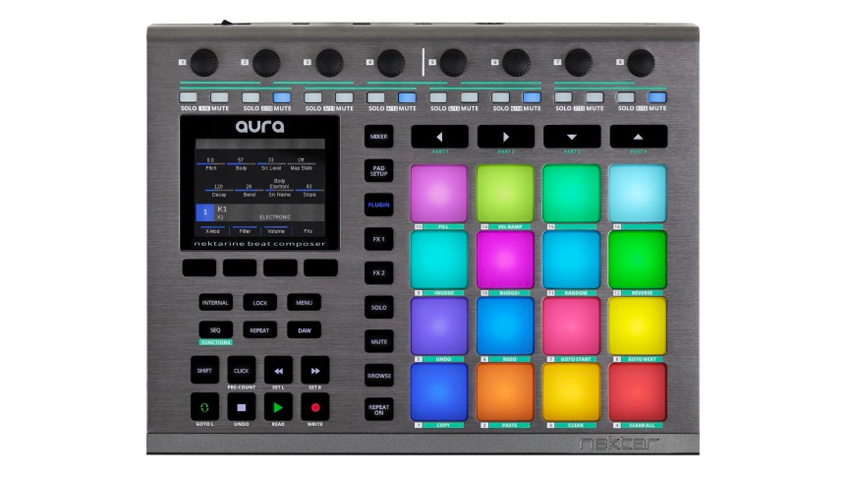NAMM 2020 VIDEO: Nektar’s Aura beatmaker and MIDI sequencer looks smarter than your average pad controller
Play your drum plugins, control your DAW and trigger your hardware
NAMM 2020: Nektar’s Aura is a beat- and performance-focused pad controller and MIDI sequencer that looks like it has some pretty advanced features. In fact, with a TFT colour display and tight plugin and DAW integration - plus the option to sequence your MIDI hardware - it has the potential to sit at the hub of your studio.
At the heart of the controller are 16 RGB-lit pressure-sensitive pads that support a flexible pad repeat mode. This enables you to use pad pressure to control velocity while changing repeat rates with the RGB LED buttons, making it easy to create dynamic rolls. Customisable parameters include Repeat Rate, Gate, Accent Interval, Accent Velocity Offset, Swing, Trigger Mode and Clock Source.
Thanks to the included Nektarine 2.0 software, you can use Aura to control your VST and AU plugins. You can fill your pads with sounds from one plugin or multiple ones - in fact, each pad can play a different plugin if you wish, making it easy to create custom kits. Assignments are saved as part of your DAW project or as a Nektarine Multi-Patch.
Using Plugin mode, you also have instant control of your plugin’s parameters, so you can tweak the likes of pitch, decay or level when you’re programming drums. Relevant parameters are automatically selected and assigned to the eight rotaries based on the last triggered pad, keeping you in control.
The Nektarine 2.0 software also offers four FX insert slots per hosted instrument plugin, giving you the option to use up to 64 effect plugins per Nektarine instance. Effects buttons enable you to select and control the hosted effect plugins, and there are a further four global send effect slots that are controlled for each instrument in Aura’s mixer page. This also enables you to control the volume, pan and mute/solo for each plugin.

There’s also a comprehensive sequencer mode that turns the pads into a 16-step programming interface. You can use 16 patterns (one for each pad) with 4 parts, giving you a total of 64 steps to work with. The fact that you can trigger parts in combination at any time - and that each pattern and part in a pattern can have a different length - gives you massive polyrhythmic potential, and there are multiple editing features, some of which can be used on a per-step basis. And, because there’s an external MIDI Out, you can use Aura standalone to sequence your hardware if you wish.
Back in the computer world, there’s tight DAW integration with the likes of Ableton Live Suite, Bitwig Studio, Cubase, Digital Performer, GarageBand, Logic, Nuendo, Reaper, Reason and Studio One. You can use Aura for transport control, track selection, project navigation and more. You can also program its controls manually, storing up to 16 presets for of assignments for the 16 pads, eight pots, seven switches and two foot switch connections.
Want all the hottest music and gear news, reviews, deals, features and more, direct to your inbox? Sign up here.
There’s no shortage of competition in the world of pad controllers - did somebody say Maschine and Push 2? - but Aura certainly looks to have a lot going for it, and if it works as promised, could be a very attractive option. It’ll be available in the spring priced at $350/£300/€350, and you can find out more on the Nektar website.



I’m the Deputy Editor of MusicRadar, having worked on the site since its launch in 2007. I previously spent eight years working on our sister magazine, Computer Music. I’ve been playing the piano, gigging in bands and failing to finish tracks at home for more than 30 years, 24 of which I’ve also spent writing about music and the ever-changing technology used to make it.